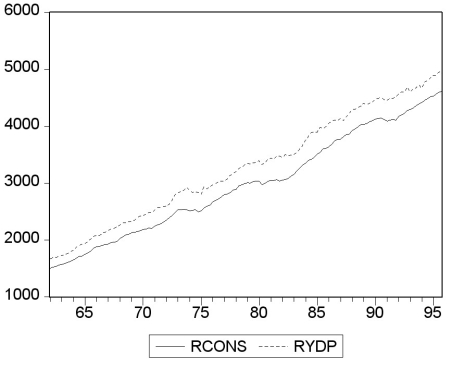Your textbook states that there "are three ways to decide if two variables can plausibly be modeled as cointegrated: use expert knowledge and economic theory, graph the series and see whether they appear to have a common stochastic trend, and perform statistical tests for cointegration. All three ways should be used in practice." Accordingly you set out to check whether (the log of)consumption and (the log of)personal disposable income are cointegrated. You collect data for the sample period 1962:I to 1995:IV and plot the two variables.  (a)Using the first two methods to examine the series for cointegration, what do you think the likely answer is?
(a)Using the first two methods to examine the series for cointegration, what do you think the likely answer is?
(b)You begin your numerical analysis by testing for a stochastic trend in the variables, using an Augmented Dickey-Fuller test. The t-statistic for the coefficient of interest is as follows: where LnYpd is (the log of)personal disposable income, and LnC is (the log of)real consumption. The estimated equation included an intercept for the two growth rates, and, in addition, a deterministic trend for the level variables. For each case make a decision about the stationarity of the variables based on the critical value of the Augmented Dickey-Fuller test statistic. Why do you think a trend was included for level variables?
(c)Using the first step of the EG-ADF procedure, you get the following result: t = -0.24 + 1.017 lnYpdt
Should you interpret this equation? Would you be impressed if you were told that the regression R2 was 0.998 and that the t-statistic for the slope was 266.06? Why or why not?
(d)The Dickey-Fuller test for the residuals for the cointegrating regressions results in a t-statistic of
(-3.64). State the null and alternative hypothesis and make a decision based on the result.
(e)You want to investigate if the slope of the cointegrating vector is one. To do so, you use the DOLS estimator and HAC standard errors. The slope coefficient is 1.024 with a standard error of 0.009. Can you reject the null hypothesis that the slope equals one?
Definitions:
Private Acceptance
Involves internalizing and genuinely agreeing with a group's beliefs or behaviors, even when no one else is observing.
Descriptive Norms
The perception of what behaviors are common or typical within a group, influencing individuals' behavior based on what they perceive others are doing.
Injunctive Norms
Socially accepted beliefs about what behaviors are deemed appropriate or inappropriate in specific contexts.
Focus Theory
A theoretical framework that suggests the focus of attention influences an individual's perception, cognition, and social behavior.
Q5: Consider the following panel data regression with
Q8: The coefficients of the VAR are estimated
Q14: The Times Series Regression with Multiple Predictors<br>A)is
Q24: Consider the model Y<sub>i</sub> = β<sub>1</sub>X<sub>i</sub>
Q27: Table 8.1 on page 284 of
Q53: Explain why the OLS estimator for the
Q70: If planned aggregate expenditure in an economy
Q82: There is $5,000,000 of currency in Econland,all
Q124: If the reserve-deposit ratio is 20% and
Q146: All of the following would be included